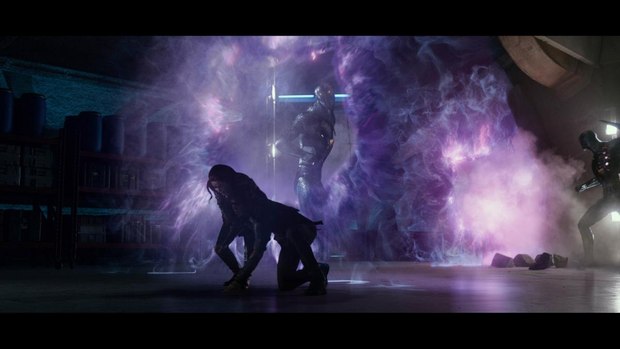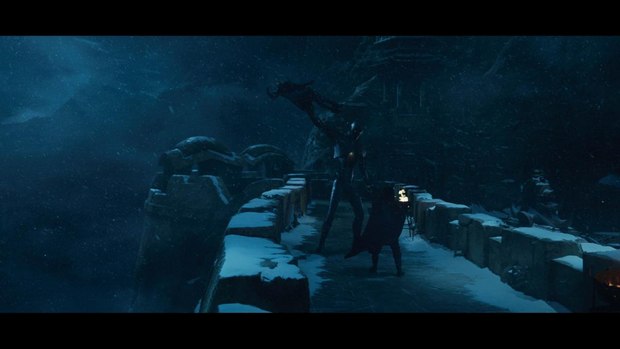MPC Montreal’s Benoit Dubuc recalls the creation of the X-Men’s greatest foes
X-Men: Days of Future Past is proving a powerhouse at the box office thanks in no small part to the appearance – finally, at long last – of the foreboding Sentinels. Glimpsed briefly in X-Men: The Last Stand’s Danger Room sequence, these massive mutant-hunting machines now finally stand front and center in what looks likely to become the most successful entry in the franchise. And if the X-Men seem to have their hands full dealing with them, consider the challenges Benoit Dubuc faced down in creating them. As animation supervisor at MPC’s Montreal studio, he had to bring together a special team of his own just to bring the Sentinels to life. Luckily, he reveals, his animators all turned out to be as X-obsessed as he is.
Dan Sarto: How long did you work on the Sentinels?
Benoit Dubuc: We started back in June of 2013 on the preproduction and development work. Officially, we started shots towards the end of August and crewed-up for the show from the end of August to October. We were in full-on production mode from October to March 2014.
DS: How did you and your team approach the creation of the Sentinels?
BD: Like the Sentinels in the comic book, they’re bipedal, so in one sense it makes their behavior pretty intuitive, but we had to find the right balance. We had to make them come across as mechanical but also extremely athletic and nimble at the same time. That was a bit of a challenge.
In the film, the future Sentinels have quite a few technological advancements that aren’t straightforward from a rigging and animation standpoint, so there was quite a bit of R&D on our end. We had a clear mandate that the Sentinels had to be capable of certain specific movements, so I worked directly with the rigging department and tried to find some solutions to these creative challenges. There was a lot of performance testing. When I came onboard the project the first thing I wanted to narrow down was what the director [Bryan Singer] would be happy with and how he’d want the Sentinels to behave in terms of physicality, agility and badassery, if you will, and doing that in-shot is always a bit risky because once you get into shot production mode you want it to flow as efficiently as possible. The VFX supervisor – Richard Stammers – was present in Montreal once we started these animation tests, so luckily he was available to lend his critical eye and give us his opinion and assessment of Bryan Singer’s view of the Sentinels.
DS: Were you able to animate anything yourself?
BD: As an animation supervisor on a VFX show, usually I’m the first on and last off a project. So when I first came on board, for about a month and a half, I was the only animator doing tests and character development. I did some of the establishing work, but I was mostly supervising the team.
DS: What assets did you start with when you began those first tests? Did you have a fully fleshed-out rig?
BD: The first rig I started with was essentially a rough bipedal rig of the model that had been previously approved by the client. The client was happy with the general design but when I started moving the character a little bit, I realized that certain limbs weren’t necessarily the right size or it was hard to hit certain poses because of the proportions of the model. So, the first pass I did was to test out the rig and also to assess whether or not the character would benefit from a bit of a redesign rather than an overhaul. It wasn’t a question of pulling away too far from what the client liked but just making sure that the model’s proportions would allow us to hit some interesting poses.
DS: Did you use any motion capture for performance?
BD: It was animated from scratch. I tried some motion capture but again, because we needed to hit a balance between robotic and organic, I felt that motion capture steered us towards something a bit too fleshy and human, so we pulled away from it. Obviously all the shots we animated, every single one, was based off of reference because we did have to make sure the biomechanics of the movements were accurate. But it was more straightforward just to hand-key it. You didn’t have any sort of fleshy artifacts to deal with.
DS: How much previs did you have to work from?
BD: The film was prevised quite heavily. It’s probably the first movie I’ve worked on where the previs matches up very closely with the end results, mostly in terms of framing and editing. It’s very, very close. Bryan Singer, who had worked with the previs quite a bit, was attached to certain sections, so in those cases, that’s what he wanted in the shot. In other cases, the previs was there just to indicate what the composition of the shot should be and it was up to us to start from scratch and find an action that was a bit more interesting or dynamic. In a couple of cases we had to literally paint everything out from the shot. The performances were fine but we just couldn’t make them work with the Sentinels so we got the approval to paint out the actors and make it a full CG shot and then propose creative ideas.
DS: What were the main challenges you faced on this project?
BD: Well first of all, the bar is very high for any big VFX movie like this. Obviously X-Men is going to be compared to The Avengers, which is another big visual feast, so the standards are very high. And like I said, the Sentinels are quite tall and svelte so to find a balance between menacing, athletic, heavy and dominant based on their character design was a challenge. What was challenging as well was that we were setting up the new MPC studio in Montreal, so while X-Men was going on, I had to build the animation department from scratch. I had to bring together the crew from all around the world and train the crew and deliver this show to a very, very high standard.
DS: That sounds pretty daunting. At the height of production, how big was your crew?
BD: We had fifteen animators. X-Men was the first show done by MPC in Montreal and at times I wished we’d started with a much smaller show, something a bit more manageable. At the same time, everybody stepped up and improved quite a bit and now any future show that we have at MPC will feel like a cakewalk compared to this!
DS: What’s the process you go through to determine if a shot is finished?
BD: In VFX we have the same approval stages as in any other form of animation. So we have a blocking stage, a primary stage, a secondary stage…there are a few more hierarchy levels in VFX than there are in an animated feature film. We mostly dealt with Richard, who presented our work to Bryan. Luckily they were pretty much on the same page the whole time. If Richard was happy with something it meant that Bryan would be happy with it. So basically, I ran the animation department and when I was happy with the animation, I presented it to Richard who then presented it to Bryan. It was a fairly smooth operation.
DS: Sounds like a pretty rewarding project overall…
BD: We were pretty much all thrilled to work on an X-Men film. I made sure when I hired the animators that they were familiar with and excited about the X-Men universe. Later on we also crewed-up for Cinderella, which is currently in production, but at some point both productions overlapped and most of the Cinderella animators at one time or another begged me to do one or two shots on the Sentinels. Everyone was that thrilled about it!
--
Dan Sarto is Publisher and Editor-in-Chief of Animation World Network
James Gartler is a Canadian writer with a serious passion for animation in all its forms. His work has appeared in the pages of Sci Fi Magazine, and at the websites EW.com and Newsarama.com.
Dan Sarto is Publisher and Editor-in-Chief of Animation World Network.


















